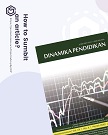Investigating Virtual Learning on Students Learning Outcomes in Urban and Rural Areas
(1) Universitas Negeri Surabaya
(2) Universitas Negeri Surabaya
(3) Universitas Negeri Surabaya
Abstract
This study aims to investigate the implementation of virtual learning on students’ learning outcomes mediated by motivation and to compare its effectiveness between urban and rural areas. This study employed quantitative design, involved 362 students of Faculty of Education in UNESA. To determine the sample, it employed Solvin’s formula. The data were collected by using three instruments, specifically Virtual Learning Effectiveness, Learning Outcomes, and Motivation. To see the difference of virtual learning on learning outcomes mediated by motivation based on student’s location, path analysis was performed twice by separating the data into two kinds of groups. The first group contains student’s data that lived in an urban area. The second group contains student’s data that lived in a rural area. The findings of this research confirm that the virtual learning is effective to improve students’ learning outcomes which was mediated by motivation. In addition, it was found that the motivation of students from urban areas is higher than those from rural areas. It suggests that the native location of students influences their motivation.
Keywords
Full Text:
PDFReferences
Agung, A. S. N., Surtikanti, M. W., & Quinones, C. A. (2020). Students’ Perception of Online Learning during COVID-19 Pandemic: A Case Study on the English Students of STKIP Pamane Talino. Soshum: Jurnal Sosial dan Humaniora, 10(2), 225-235.
Akbarini, N., Murtini, W., & Rahmanto, A. (2018). The Development of Lectora Inspire-Based Interactive Learning on General Administration Subject. Dinamika Pendidikan, 13(1), 72-79. https://doi.org/10.15294/dp.v13i1.13006
Akpan, N., & Offong, A. U. (2019). School Location, Human Resources and Financial Accounting Students Motivation in Public Secondary Schools in Uyo Local Education Committee.
Alkıs, N., & Temizel, T. T. (2018). The impact of motivation and personality on academic performance in online and blended learning environments. Journal of Educational Technology & Society, 21(3), 35-47.
Ally, M. (2004). Foundations of educational theory for online learning. In Terry (Ed.), The theory and practice of online learning (pp. 3−31). (2nd ed). Athabasca, AB: Athabasca University.
Alina, Z. (2006). Learning styles and online education. Campus-Wide Information Systems, 23(5), 325–335. https://doi.org/10.1108/10650740610714080
Ayala Calvo, J. C., & Manzano García, G. (2021). The influence of psychological capital on graduates’ perception of employability: the mediating role of employability skills. Higher Education Research & Development, 40(2), 293–308. https://doi.org/10.1080/07294360.2020.1738350
Baron, R. A., & Greenberg, J. (1990). Behavior in Organization: Understanding and Managing the Human Side of Work (3th ed.). Toronto: Allyn & Bacon.
Baber, H. (2020). Determinants of Students’ Perceived Learning Outcome and Satisfaction in Online Learning during the Pandemic of COVID-19. Journal of Education and e-Learning Research, 7(3), 285-292.
Benson, A. (2002). Using online learning to meet workforce demand: A case study of stakeholder influence. Quarterly Review of Distance Education, 3(4), 443−452.
Benson, L., Elliot, D., Grant, M., Holschuh, D., Kim, B., Kim, H., et al. (2002). Usability and instructional design heuristics for e-Learning evaluation. In P., & S. (Eds.), Proceedings of World Conference on Educational Multimedia, Hypermedia and Telecommunications 2002 (pp. 1615−1621).
BNPB. (2020). Badan Nasional Penanggulangan Bencana – Covid19.go.id.
Carliner, S. (2004). An overview of online learning (2nd ed.). Armherst, MA: Human Resource Development Press.
Christiana, E. (2020). Burnout akademik selama pandemi Covid 19. Prosiding Seminar Nasional Bimbingan Dan Konseling Mengukuhkan Eksistensi Peran BK Pasca Pandemi Covid-19 Di Berbagai Setting Pendidikan, 8–15.
Conrad, D. (2002). Deep in the hearts of learners: Insights into the nature of online community. Journal of Distance Education, 17(1), 1−19.
Dalmau, Halfis, & D. (2017). Taking a Fresh Look in Education. Rotterdam: Sense Publishers.
Deci, E. L., & Ryan, R. M. (2016). Optimizing students’ motivation in the era of testing and pressure: A self-determination theory perspective In Building autonomous learners. Singapore: Springer.
DeMatthews, D., Knight, D., Reyes, P., Benedict, A., & Callahan, R. (2020). From the Field: Education Research During a Pandemic. Educational Researcher, 49(6), 398–402. https://doi.org/10.3102/0013189X20938761.
Dewi, W. A. F. (2020). Dampak Covid-19 terhadap implementasi pembelajaran daring di Sekolah Dasar. Edukatif: Jurnal Ilmu Pendidikan, 2(1), 55-61.
Dhawan, S. (2020). Online learning: A panacea in the time of COVID-19 crisis. Journal of Educational Technology Systems, 49(1), 5-22.
Dutta, A. (2020). Impact of digital social media on Indian higher education: alternative approaches of online learning during COVID-19 pandemic crisis. International journal of scientific and research publications, 10(5), 604-611.
Firman, & Rahman, S. R. (2020). Pembelajaran Online di Tengah Pandemi Covid-19 Firman1, Sari Rahayu Rahman1. Indonesian Journal of Educational Science (IJES), 2(2), 81–89.
Francis, M. K., Wormington, S. V., & Hulleman, C. (2019). The costs of online learning: Examining differences in motivation and academic outcomes in online and face-to-face community college developmental mathematics courses. Frontiers in psychology, 10, 2054.
Harsasi, M. (2015). The Use of Open Educational Resources in Online Learning: A Study of Students' Perception. Turkish Online Journal of Distance Education, 16(3), 74-87.
Hendrayati, H. & B. P. (2013). Implementasi Model Hybrid Learning Pada Proses Pembelajaran Mata Kuliah Statistika II di Prodi Manajemen FPEB UPI. Jurnal Penelitian Pendidikan, 13(2).
Hiltz, S. R., & Turoff, M. (2005). Education goes digital: The evolution of online learning and the revolution in higher education. Communications of the ACM, 48(10), 59−64, doi:10.1145/1089107.1089139.
Hurlock E.B. (2000). Psikologi Perkembangan. Jakarta: Erlangga.
Hwa, S. P. (2018). Pedagogical change in mathematics learning. Educational Technology and Society, 21(4), 259–276.
Islam, S., Baharun, H., Muali, C., Ghufron, M. I., Bali, M. M. E. I., Wijaya, M., & Marzuki, I. (2018, November). To boost students’ motivation and achievement through blended learning. In Journal of Physics: Conference Series (Vol. 1114, pp. 1-11).
Lai, M., Mcnaughton, S., Jesson, R., & Wilson, A. (2020). Learning to Learn. https://doi.org/10.1108/978-1-78973-571-020201008.
Lestari, P. A. S., & Gunawan, G. (2020). The Impact of Covid-19 Pandemic on Learning Implementation of Primary and Secondary School Levels. Indonesian Journal of Elementary and Childhood Education, 1(2), 58-63.
Lie, A., Tamah, S. M., Gozali, I., Triwidayati, K. R., Utami, T. S. D., & Jemadi, F. (2020). Secondary school language teachers’ online learning engagement during the Covid-19 pandemic in Indonesia. Journal of In- formation Technology Education: Research, 19, 803-832. https://doi.org/10.28945/4626
Moore, J. L., Dickson-Deane, C., & Galyen, K. (2011). e-Learning, online learning, and distance learning environments: Are they the same? The Internet and Higher Education, 14(2), 129-135.
Nambiar, D. (2020). The impact of online learning during Covid-19: students’ and teachers’ perspective. The International Journal of Indian Psychology, 8(2), 783-793.
Ningsih, S. (2020). Persepsi Mahasiswa Terhadap Pembelajaran Daring Pada Masa Pandemi Covid-19. JINOTEP (Jurnal Inovasi dan Teknologi Pembelajaran): Kajian dan Riset Dalam Teknologi Pembelajaran, 7(2), 124-132.
Oblinger, D., Oblinger, J. L., & Lippincott, J. K. (2005). Educating the net generation. Boulder, Colo.: EDUCAUSE, c2005. 1 v. (various pagings): illustrations.
Rahmat, A., & Akbar, M. (2019). A Comparative Analysis of English Learning Motivation between the Rural and Urban Students. Metathesis: Journal of English Language, Literature, and Teaching, 3(2), 158-182.
Rapanta, C., Botturi, L., Goodyear, P., Guàrdia, L., & Koole, M. (2020). Online university teaching during and after the Covid-19 crisis: Refocusing teacher presence and learning activity. Postdigital Science and Education, 2(3), 923-945.
Riswanto, A., & Aryani, S. (2017). Learning motivation and student achievement: description analysis and relationships both. COUNS-EDU: The International Journal of Counseling and Education, 2, 42. https://doi.org/10.23916/002017026010
Royle, M. T., & Hall, A. T. (2012). Theory of Needs, Feeling Individually. International Journal of Management and Marketing Research, 5(1), 21–42. https://doi.org/10.1016/j.bmcl.2004.04.023
Rybnicek, R., Bergner, S., & Gutschelhofer, A. (2019). How individual needs influence motivation effects: a neuroscientific study on McClelland’s need theory. In Review of Managerial Science (Vol. 13). Springer Berlin Heidelberg. https://doi.org/10.1007/s11846-017-0252-1
Santrock, J. W. (2003). Adolescence: Psikologi Remaja. Jakarta: Erlangga.
Schaufeli, W. B. (2002). Burnout and Engagement in University Students: A Cross-National Study. Journal of Cross-Cultural Psychology, 3(5).
Schunk, D. H. (1991). Self-Efficacy and Academic Motivation. Educational Psychologist, 26(3–4), 207–231. https://doi.org/10.1080/00461520.1991.9653133
Schunk, D. H. (2012). Learning theories: An educational perspective. In Reading (Vol. 5).
Setiawan, B., & Iasha, V. (2020). Covid-19 Pandemic: The Influence of Full-Online Learning for Elementary School in Rural Areas. JPsd (Jurnal Pendidikan Sekolah Dasar), 6(2), 114-123.
Shahroom, A. A., & Hussin, N. (2018). Industrial Revolution 4.0 and Education. International Journal of Academic Research in Business and Social Sciences, 8(9), 314–319. https://doi.org/10.6007/ijarbss/v8-i9/4593
Thorburn, M., & Collins, D. (2003). Integrated Curriculum Models and their Effects on Teachers’ Pedagogy Practices. European Physical Education Review, 9(2), 185–209. https://doi.org/10.1177/1356336X03009002004.
Vanslambrouck, S., Zhu, C., Lombaerts, K., Philipsen, B., & Tondeur, J. (2018). Students' motivation and subjective task value of participating in online and blended learning environments. The Internet and Higher Education, 36, 33-40.
Zadina, J. N. (2014). Multiple pathways to the student brain: Energizing and enhancing instruction. In Multiple pathways to the student brain: Energizing and enhancing instruction.
Zhafira, N. H., Ertika, Y., & Chairiyaton, C. (2020). Persepsi Mahasiswa Terhadap Perkuliahan Daring Sebagai Sarana Pembelajaran. Jurnal Bisnis Dan Kajian Strategi Manajemen, 4(1).
Zhang, Q., Bonafini, F. C., Lockee, B. B., Jablokow, K. W., & Hu, X. (2019). Exploring demographics and students’ motivation as predictors of completion of a massive open online course. International Review of Research in Open and Distributed Learning, 20(2).
Refbacks
- There are currently no refbacks.

This work is licensed under a Creative Commons Attribution 4.0 International License.

.png)

.png)





